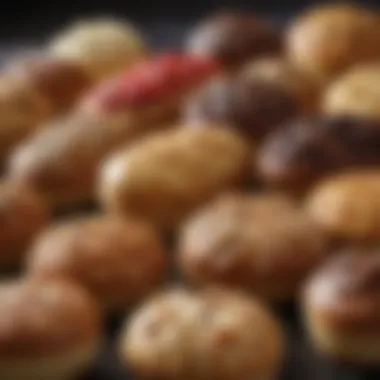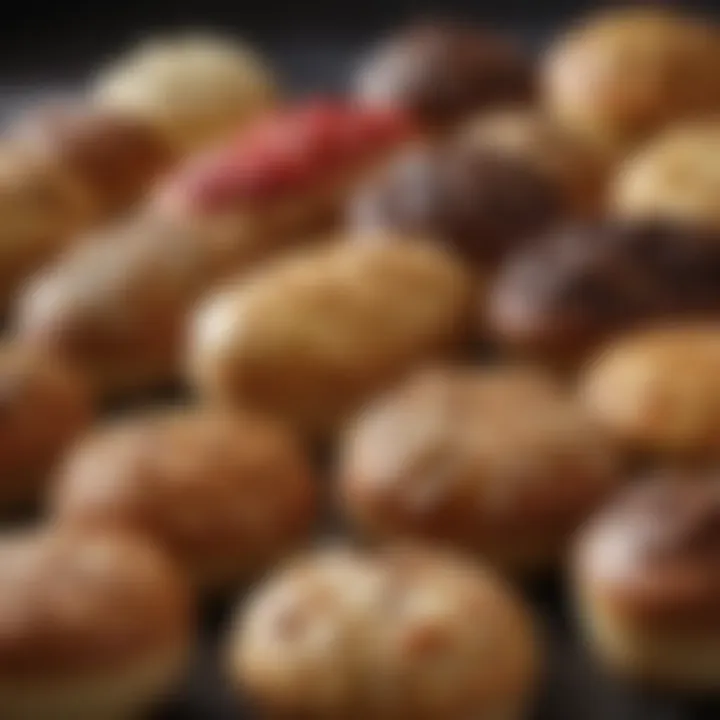The Art of Easy Baking: A Comprehensive Exploration


Intro
Baking doesn’t have to be a daunting culinary task. In fact, it can be as easy as pie—or in some cases, a simple loaf of bread. This article aims to peel back the layers on easy baking, inviting you into a world where even the most inexperienced bakers can create delicious treats with confidence. Whether you're a budding chef or someone who has rarely stepped foot in the kitchen, the art of easy baking is about making the entire experience enjoyable and fulfilling.
When we think about baking, we often picture complicated recipes that require a trove of ingredients and hours of preparation. However, the beauty of easy baking is that it strips down these elaborate processes and highlights straightforward techniques that deliver delightful results. The discussion will not only encompass handy tools and recipes but also emphasize the nutritional aspect that many busy cooks overlook. So, buckle your apron as we dive into the essentials of easy baking, exploring ingredients, recipes, and techniques that can transform your kitchen efforts into pure joy.
Recipe Overview
Recipe Name and Description
This section will provide a closer look at a selected baking recipe that epitomizes the concept of easy baking.
Imagine creating a fluffy banana bread that requires just a few overripe bananas, flour, sugar, and eggs. This quick bread is versatile, offering a wholesome option for breakfast or a snack. It melts in your mouth, and the aroma wafting through your kitchen will have everyone asking when they can have a slice.
Cuisine Type
Coming from the American cuisine repertoire, this banana bread is a timeless classic that is not only easy to whip up but also adaptable. You can throw in walnuts or chocolate chips, depending on your mood or dietary preference.
Ingredients List
Detailed Ingredient Breakdown
A quick look at everything you need to bring this banana bread to life:
- 3 ripe bananas
- 1/3 cup melted butter
- 1 cup sugar
- 1 egg
- 1 teaspoon vanilla extract
- 1 teaspoon baking soda
- Pinch of salt
- 1 1/2 cups all-purpose flour
These ingredients can easily be found in any grocery store, making this a practical choice for many home cooks.
Substitutions for Dietary Needs
If you’re considering dietary restrictions, this recipe can be adjusted effortlessly. For instance:
- Vegan Option: Substitute the egg with a flaxseed mixture (1 tablespoon of ground flaxseed + 2.5 tablespoons of water).
- Gluten-Free Option: Replace all-purpose flour with a gluten-free flour blend.
- Sugar-Free Option: Use ripe bananas in place of sugar or a sugar substitute that works for baking, like stevia.
This adaptability allows bakers of all dietary backgrounds to partake in this delightful experience without feeling left out. With these foundations in place, we can further explore the nuances of easy baking, illuminating the path for those who wish to experiment and create with accessible methods.
Understanding Easy Baking
Baking, for some, seems like a meticulous process requiring patience, precision, and a wealth of knowledge about techniques and ingredients. However, the concept of easy baking seeks to peel away the layers of complexity, presenting a more welcoming entrance to the culinary art of creating baked goods. Emphasizing simplicity and accessibility, this approach invites both seasoned bakers and amateurs to explore the joys of creating edible delights in their kitchens without feeling overwhelmed.
The essence of easy baking lies in its ability to break down traditional barriers. It not only encourages usage of straightforward recipes, but also highlights the importance of adaptability in the kitchen. In our fast-paced world, finding joy in food preparation amidst busy schedules is not just a luxury but a necessity for many. Engaging with easy baking can serve as a creative outlet, allowing one to express individuality while delivering comfort—whether it’s a warm loaf of bread or a simple cake.
Through understanding easy baking, bakers can benefit in several ways:
- Boosting Confidence: Starting with simpler recipes allows novice bakers to build their skills gradually. This way, the kitchen remains a space of experimentation rather than anxiety.
- Encouraging Creativity: With accessible ingredients and methods, there’s room to innovate. Substitutions and alterations become a playground of flavors and textures, inspiring bakers to think outside the box.
- Fostering Connections: Sharing easy-to-follow recipes can cultivate a sense of community. Whether it be through family gatherings or online forums, people come together through the shared experience of baking.
In summary, understanding easy baking is pivotal in navigating the world of culinary creation. It opens doors to various possibilities while ensuring joy remains central to the experience of baking.
Defining Easy Baking
The phrase "easy baking" speaks volumes. It suggests an approach where effort meets reward without a hefty price tag in terms of time and complexity. At its core, easy baking is about uncovering techniques and recipes that anyone can master without extensive prior knowledge. It's inviting, approachable, and often liberating.
The characteristics of easy baking include:
- Simplicity: Recipes typically utilize a minimal number of ingredients. This not only shortens preparation time but also simplifies the shopping experience.
- Clarity: Instructions tend to be straightforward, lacking in unnecessary steps that might confuse someone new to baking.
- Flexibility: Most easy baking recipes lend themselves to interpretations—feel free to throw in a handful of chocolate chips even if the recipe doesn’t call for it!
In essence, defining easy baking is akin to describing a warm hug on a cold day—comforting, simple, and incredibly satisfying.
Historical Context of Baking Simplified
To appreciate easy baking fully, one must recognize its roots in a rich tapestry of historical practices. For centuries, baking was an intricate, labor-intensive skill largely restricted to professional bakers or those with ample time and resources. The art form flourished in various households, often transformed into community events where families and neighbors would gather to create bread, pastries, and pies.
With the advent of modern technology, however, the landscape of baking began to shift. The introduction of processed ingredients, pre-packaged mixes, and cooking appliances like microwaves and stand mixers made baking more accessible. No longer did one need to knead dough by hand for hours; a quick mix could yield the same result in a fraction of the time.
Moreover, the rise of the internet paved the way for a cultural shift where sharing recipes became a communal endeavor. This pooling of knowledge contributed to the evolution of baking, stripping away the elitism and making it more inclusive. Online platforms and social media have become fertile ground for ideas, allowing bakers to swap tips, share innovative shortcuts, and inspire each other.
"Baking is not just a procedure; it’s a conversation between the past and the present, allowing each of us to partake in a shared human experience."


By exploring these elements, readers can better grasp the significance of easy baking and its implications for a modern culinary culture.
Fundamentals of Baking Ingredients
Understanding the essential components of baking ingredients is crucial for anyone looking to simplify their baking experience. The right ingredients not only ensure that your baked goods turn out perfectly, but they can also enhance the taste, texture, and overall appeal of your creations. Using simple and accessible ingredients can make baking less intimidating, especially for those just starting their culinary journey.
Baking ingredients can be divided into several categories, each serving a specific purpose in the recipe. By grasping the fundamentals of these ingredients, bakers can make informed choices that align with their health preferences, dietary restrictions, and creativity in the kitchen.
When you think about baking, certain ingredients often come to mind: flour, sugar, butter, eggs, and leavening agents. Each plays an integral role in the transformation of simple ingredients into delicious treats. Moreover, understanding how these ingredients interact with one another helps you become more adaptable in the kitchen.
Essential Baking Ingredients
Baking hinges on a few key players that form the backbone of many recipes. Here’s a closer look at the most crucial ingredients:
- Flour: The foundation of most baked goods, flour provides structure. Different types, such as all-purpose, whole wheat, or cake flour, offer varied properties. For instance, whole wheat flour contains more fiber and flavor, making it a healthier alternative without sacrificing taste.
- Sugar: Beyond sweetness, sugar enhances the texture and browning of baked goods. Brown sugar adds moisture and a hint of caramel flavor, while granulated sugar is often used for texture.
- Fat: Butter or oil contributes to the moistness and richness of your baked goods. Butter, especially, can add a depth of flavor that oil simply can't match. If you're aiming for easier baking, consider using a baking spray as an alternative; it makes cleanup a breeze!
- Eggs: They serve multiple roles: binding ingredients together, adding moisture, and helping with leavening. For vegans or those with egg allergies, alternatives like applesauce or flaxseed meal can substitute effectively in many recipes.
- Leavening Agents: Baking powder and baking soda are what cause baked goods to rise. It's important to measure them accurately. Too much soda can leave a metallic taste, while too little can result in dense products.
By mastering these basic ingredients, you can gain confidence in your ability to whip up a variety of treats, from bread and cakes to cookies and pastries.
Substitutions and Alternatives for Easy Baking
As with all cooking, flexibility is key in baking. Ingredients can sometimes be hard to come by, or you may want to adapt recipes to fit dietary needs or preferences. Substitutions can simplify your baking while maintaining delightful results. Here are a few commonly used alternatives:
- Flour Substitutions: Almond flour, coconut flour, and oat flour can be excellent gluten-free alternatives. Note that they may require adjustments in the amount of liquid used in the recipe due to their different absorption properties.
- Sweeteners: If you want to cut down on refined sugar, try sweeteners like honey, maple syrup, or agave nectar. These options not only provide sweetness but also add unique flavors.
- Fats: For a lower calorie or dairy-free option, coconut oil or applesauce can work well instead of butter in many recipes. They can provide a moist texture while accommodating various dietary choices.
- Egg Replacements: When a recipe calls for eggs, consider using mashed bananas, unsweetened applesauce, or even silken tofu. These not only bind ingredients but also contribute moisture, helping to keep your baked goods tender.
"In the world of easy baking, adaptability is your best friend. The more you know about substitutions, the more creative you can be!"
With a solid understanding of essential baking ingredients and their possible alternatives, you can create delightful recipes without the need for extensive shopping. This knowledge not only saves time but encourages a more confident approach to baking at home.
Tools for Simple Baking
In the realm of easy baking, the right tools can make all the difference. They simplify the process, enhance results, and often encourage a more enjoyable baking experience. For home bakers navigating the world of desserts and breads, understanding which tools are essential and which ones can elevate their baking prowess is paramount. The journey toward creating delicious baked goods becomes infinitely easier with the right set of equipment at your fingertips.
Must-Have Baking Equipment
When it comes to easy baking, some tools are non-negotiable. Here’s a lineup that every aspiring baker should consider:
- Mixing Bowls: These come in various sizes, allowing you to tackle everything from whisking a single egg to mixing a cake batter big enough for a party. Stainless steel and glass options are particularly popular because they are durable and easy to clean.
- Measuring Cups and Spoons: Precision is key in baking. A good set of measuring tools will ensure you get the ratios just right, which can be the difference between a perfect cake and a crumbly mess.
- Baking Sheets and Pans: Having a variety of baking sheets and pans—like cookie sheets, loaf tins, and cake pans—will allow bakers to explore a multitude of recipes. Non-stick options can make cleanup a breeze.
- Whisk and Rubber Spatula: These tools are ideal for mixing and folding ingredients gently. A whisk aerates the mixture while a spatula ensures you get every last bit of batter out of the bowl—no waste!
- Oven Thermometer: An often-overlooked piece of equipment is the oven thermometer. Ovens can sometimes be off by quite a bit, and knowing the exact temperature can prevent underbaking or burning.
Having these tools at hand streamlines the baking process and gives beginners the confidence to experiment with new recipes.
Optional Tools to Enhance the Experience
For those looking to take their baking to the next level, consider adding some optional tools that can enhance creativity and efficiency:
- Stand Mixer: While a handheld mixer does the job, a stand mixer virtually does the work for you. Perfect for doughs or batters that require extensive mixing, it saves both time and elbow grease.
- Silicone Baking Mats: These reusable mats are great for those who want to eliminate waste while ensuring their cookies don’t stick. They provide a non-stick surface perfect for baking biscuits and pastries.
- Kitchen Scale: Baking by weight can be more accurate than measuring by volume, especially when it comes to dry ingredients. A digital kitchen scale can make recipes far more precise.
- Sifting Tool: Whether it’s flour or powdered sugar, sifting can help achieve a light and airy texture in baked goods. A simple hand sifter can make this process quick and easy.
- Food Processor: This multi-functional tool can be used for chopping nuts, mixing dough, or pureeing fruits for fillings. It’s a powerhouse in the kitchen that can save time in the prep stage.
Investing in these optional tools not only makes baking easier but also opens up new culinary possibilities, allowing bakers to explore more complex techniques and recipes. They emphasize the idea that with the right tools, anyone can become a proficient baker, regardless of experience level.
"Baking is both science and art; having the right tools is the canvas that allows this creativity to flourish."
By thoughtfully selecting baking equipment, you can not only make the task simpler but also have fun creating delectable treats.
Techniques to Simplify Baking
Baking, while often seen as an intricate art, can be streamlined with practical techniques that make the process not only easier but also more enjoyable. In this section, we will examine strategies to save time and effort in the kitchen, making easy baking accessible to everyone from novice bakers to seasoned cooks. The focus here is on adaptability and efficiency, providing insights to minimize hassle and maximize delicious results.
Mixing Methods that Save Time
Getting ingredients combined is a fundamental step in baking, but it can become quite laborious if done traditionally. Several mixing methods offer significant time savings without sacrificing quality:
- Cake Mix Method: This method is straightforward—combine dry ingredients separately from wet ones, and then mix them together. This allows for quicker incorporation without overmixing, which can lead to tougher textures.
- One-Bowl Method: This technique involves adding all ingredients into one bowl, usually starting with wet ones followed by dry. It’s a game changer, especially for quick breads and muffins where time is of the essence.
- Stand Mixer Use: Investing some time into learning how to use a stand mixer can pay dividends. With hooks for kneading dough or paddles for mixing batters, a stand mixer reduces the physical labor involved in baking.
Utilizing these methods can simplify the mixing process significantly, ensuring that baking doesn’t turn into a daunting task.
"Time spent in the kitchen should be a joy, not a chore. Embrace the techniques that allow you to focus on flavor rather than fuss."
Batch Baking: Efficiency in the Kitchen


Batch baking is not merely a time-saving hack; it's a smarter strategy for anyone looking to optimize their baking routine. This approach saves time, ingredients, and even energy. Here’s how you can embrace batch baking:
- Cook Once, Enjoy Multiple Times: By preparing large quantities of a single recipe, you reduce the number of times you need to heat the oven, which is more efficient and energy-saving.
- Freezing for Future Use: Many baked goods freeze well. Baking multiple loaves of bread or stacks of cookies can provide delightful treats down the line, just waiting to be revived in the oven for a fresh bite.
- Experiment with Variations: White bread today? Try whole wheat next time. Batch baking allows for experimentation with flavors and ingredients, thus keeping the baking routine exciting.
Batch baking transcends merely creating a surplus; it transforms baking into a more strategic and satisfying endeavor. By adopting these techniques, bakers can reclaim precious time while enjoying the fruits of their labor without feeling overwhelmed.
Profiles of Easy Baking Recipes
When it comes to easy baking, the recipes one chooses can make all the difference in the world. Easy baking recipes not only simplify the process but also cater to varying skill levels, making it accessible for everyone—from the novice who’s just dipping their toe into the culinary waters to the seasoned baker looking for a quick and satisfying project. Moreover, these recipes play a pivotal role in building confidence in the kitchen, allowing cooks to explore their creativity without the fear of intricate techniques or time constraints.
Easy baking recipes often emphasize simplicity with delightful results. They provide a sense of accomplishment, which can be exceedingly rewarding for those new to baking. In a world where fast-paced lifestyles often push home-cooked meals to the backburner, the allure of straightforward recipes comes like a breath of fresh air—inviting people to experience the joy of creating something delicious.
Whether it’s a quick bread recipe that takes just a handful of ingredients or a no-bake dessert that requires minimal effort, these profiles serve as guides to understanding how we can all engage with and enjoy the wonders of baking.
"The simplest recipes often bring the most joy, allowing us to share our creations without the pressure of perfection."
Each recipe tells a story, and knowing which profiles resonate most can help in making judicious choices that are both practical and pleasurable.
Quick Breads: A Beginner's Favorite
Quick breads are the shining stars in the world of easy baking. By definition, quick breads rely on leavening agents such as baking soda or baking powder instead of yeast, making them remarkably fast to prepare. This style of bread does not require kneading or long rises, which is perfect for beginners who might not yet have the experience or patience to work with yeast-based doughs. Not only are they easy, but quick breads are also versatile—ranging from sweet banana bread to savory cornbread, the flavor combinations are limitless.
Here are some key points that spotlight the beauty of quick breads:
- Speed: With preparation and baking time often clocking in under an hour, they cater to those needing a quick fix.
- Ingredient Accessibility: Many recipes utilize staple kitchen ingredients, allowing for spontaneous baking on a whim.
- Customizability: Substituting flavors or ingredients means there’s room for creativity. Want to add nuts, chocolate chips, or spices? Go for it!
- Gifting Potential: A loaf of homemade quick bread wrapped in parchment can be a thoughtful gift, perfect for any occasion.
No-Bake Desserts: For When Time is Short
No-bake desserts have risen in popularity, particularly among busy individuals who cherish the idea of homemade treats but lack the time and resources for a full baking session. These recipes generally involve tossing together a few ingredients—often in a mixing bowl or a food processor—then chilling in the fridge to set. Think cheesecakes, icebox cakes, and chocolate mousse, where the need for oven time is entirely eliminated.
The allure remains clear:
- Convenience: The absence of cooking means an easier cleanup, making it appealing in an already hectic kitchen.
- Creative Experimentation: They often allow for unique ingredient swaps, such as using coconut cream instead of heavy cream or gluten-free biscuits for crusts.
- Aesthetic Appeal: Many no-bake desserts can be arranged beautifully in jars or bowls, making them not just tasty but also visually pleasing for gatherings.
- Low-Pressure Cooking: Without the stress of timing in the oven, bakers can focus on flavor and presentation.
Together, these profiles present a comprehensive look at how easy baking can fit seamlessly into a busy lifestyle while still offering delicious outcomes. Exploring easy baking recipes ignites creativity, making the kitchen a place of joy and accomplishment.
Sharing these recipes not only enhances individual culinary skills but can also bring people together, whether it’s in the form of communal cooking sessions or pitching in for a local bake sale. As such, they contribute to a broader baking community that celebrates accessibility and delight in every bite.
Health and Nutrition in Easy Baking
When talking about baking, the focus often lingers on the sweet aroma and the delightful treat that emerges from the oven. However, weaving health and nutrition into the fabric of easy baking turns this culinary experience into something far more enriching. With a keen awareness of what goes into our baked goods, we not only satisfy our sweet tooth but also fortify our bodies. The emphasis on healthier choices is particularly vital in a world where convenience often overshadows nutritional benefits. Simple swaps can lead us to create treats that don't just taste good but are also aligned with a wholesome diet.
Incorporating Nutritious Ingredients
Incorporating nutritious ingredients into baking is like adding a secret ingredient that enhances both flavor and health benefits. It’s about being resourceful and making conscious choices about what you put into your baked goods. For instance, using whole wheat flour instead of all-purpose flour adds fiber, which can keep you feeling fuller for longer. Adding ingredients like oats or chia seeds can introduce additional protein, making your baking not just a dessert but also a potential energy booster.
Here are some key ingredients to consider:
- Nut flours (like almond flour) provide healthy fats and proteins.
- Greek yogurt can replace heavy creams. It offers creaminess with added protein.
- Fruit purees such as applesauce or mashed bananas can reduce sugar while adding moisture.
- Spices and herbs, like cinnamon or ginger, not only enhance taste but also have antioxidant properties.
- Dark chocolate, with its lower sugar content and abundant antioxidants, is a much better choice for the chocolate lover.
"Good baking needn’t compromise on nutrition. Every spoonful can be a delightful experience for your taste buds and a boon for your health."
Understanding Dietary Requirements
Today's world presents an array of dietary needs, and accommodating these is crucial in easy baking. Understanding dietary requirements means recognizing that not all eaters have the same culinary preferences or health goals. Whether dealing with gluten intolerance, vegan lifestyles, or sugar sensitivities, easy baking can adjust accordingly. The good news is that there’s usually a workaround.
Here’s how you can navigate through various dietary needs:
- Gluten-Free Options: Substituting gluten-containing flours with almond, coconut, or rice flour allows those with gluten sensitivities to enjoy baked goods without worry.
- ** Vegan Recipes**: Using flaxseed meal or chia seeds mixed with water as a binding agent can replace eggs in most recipes. There are also excellent non-dairy milk options that work well in place of traditional milk.
- Low Sugar or Sugar-Free Baking: Natural sweeteners like honey, agave nectar, or stevia can be used to cut down on refined sugar while still providing sweetness.
By integrating health-conscious ingredients and being mindful of dietary requirements, easy baking transforms from a simple act of mixing flour and sugar into an opportunity to create delectable goods that cater to the health of all eaters.
As we dive deeper into the world of easy baking, let us not forget that what we eat shapes our well-being. Making informed choices allows us to enjoy our culinary creations without compromising our health.
Cultural Influences on Easy Baking Practices
In the world of baking, the impact of culture cannot be overstated. Every culture brings its own twist to the art, and this diversity not only enriches the baking arena but also makes it accessible and engaging for everyone. Understanding these cultural influences is essential, as they help shape the methods, ingredients, and even the way people connect with baking. As we explore this section, we’ll delve into how various traditions and innovations in baking celebrate local flavors while creating a sense of community.


International Easy Baking Recipes
Baking practices unfold across continents, each with unique flair and creativity. Some dishes have become staples in households worldwide, thanks to their simplicity and flavor. For example, consider the easy Portuguese "Pão de Deus," a coconut-topped bread that combines minimal ingredients with maximum taste. This fluffy delight requires little more than flour, sugar, and coconut, mirroring the spirit of easy baking.
Similarly, the celebrated Italian "Ciambella," a ring-shaped cake, invites home bakers into a world of flavor without the need for extensive experience. With straightforward processes and comforting ingredients like yogurt or ricotta, it illustrates how international recipes can foster confidence in the kitchen. As bakers adopt these recipes, they not only prepare food but also partake in a rich tradition that tells a story of culture and creativity.
Traditional recipes often come with a twist. For instance, the traditional British scones have seen variations with herbs or spices from diverse culinary traditions, reflecting the ongoing evolution in easy baking. Each recipe becomes a canvas, mixing your personal tastes with cultural inspiration.
Here are some examples of international baking recipes that are easy to tackle:
- Churros (Spain) - Easy, crispy dough sprinkled with sugar, served with chocolate sauce.
- Danish Pastries (Denmark) - Flaky layers filled with fruit or cream cheese, delightful yet achievable.
- Pavlova (Australia/New Zealand) - A simple meringue dessert topped with cream and fresh fruit, requiring minimal kitchen gear.
Traditions and Innovations in Baking
Baking isn’t just a recipe following exercise; it is steeped in tradition. These traditions foster connection among families and communities, often passed down through generations. While some may hold onto the time-honored methods, others are carving out new paths through innovative baking techniques.
Consider the modern trend of incorporating health-conscious alternatives to traditional recipes. Innovations such as almond flour or avocado-based recipes have gained ground, proving that easy baking can evolve without losing its essence. Moreover, global exchanges have led to blending techniques from various cultures—like adopting the Japanese water cake method in traditional Western baking.
Baking competitions, local festivals, and community gatherings further portray how baking traditions are celebrated. People come together, sharing their baked goods, telling stories, and forming bonds that underline the importance of cultural practices in shaping baking. They also open the porthole for novices to learn from experienced bakers in an enjoyable atmosphere.
This cross-pollination between tradition and innovation not only keeps baking alive but ensures it flourishes amidst societal changes.
"Baking is not just about creating; it's about expressing culture, history, and community through simple recipes that anyone can take on."
Through a careful interweaving of the old and new, easy baking becomes a powerful conduit for cultural expression, enabling individuals from different backgrounds to connect while also finding joy in the process. As we continue to embrace our cultures, we’ll find that the kitchen becomes a gathering place where cooking traditions live and evolve.
Community Aspects of Easy Baking
The world of easy baking is not just about following recipes and mixing ingredients. It's also about the connections we build with each other, sharing experiences, and evolving together as bakers. This communal aspect plays a pivotal role in making the baking journey enjoyable and enriching. Engaging with others who share the same passion can transform baking from a solitary activity into a vibrant exchange of ideas and encouragement.
Engaging with Online Baking Communities
In today's digital age, online baking communities have blossomed like sourdough bread left to rise. Platforms such as Facebook and Reddit offer a wealth of resources where bakers can connect, learn, and share. These spaces invite everyone, from dough novices to seasoned bakers, to come together and contribute. In these digital hubs, members typically share tips, tricks, and often their successes and flops alike. The lessons learned — both from triumphs and mistakes — can become invaluable for those who are just starting out or looking to improve their skills.
Joining one of these groups can offer immediate benefits. For instance, you can:
- Ask Questions: No query is too small. Whether it’s about the right flour to use or how to avoid a soggy bottom, there’s usually someone ready to lend a helping hand.
- Seek Inspiration: Some users post pictures of their latest bakes, which can spark creativity and help others envision what they can achieve.
- Participate in Challenges: Many communities organize monthly baking challenges, pushing you to try new things and expand your horizons.
Importantly, these interactions can build a sense of belonging, something that often makes the process more joyful. As many bakers say, being part of a community can lift your spirits, especially when things don’t go as planned.
"Baking is always better with friends, no matter if it's virtual or in person!"
Sharing Success Stories and Learning Together
Success stories are the heart and soul of any baking community. When someone shares the joy of their first successful loaf of bread or the perfect cake, it resonates with others, creating a cycle of positivity and eagerness to explore further. These narratives not only boost confidence but also serve as relatable markers of growth — a reminder that every great baker started somewhere.
When members post about their achievements, it opens the door for a valuable discussion. Others can chime in with their encouragement or share similar experiences, which can help demystify the process of baking. Here are some key aspects of sharing success in these communities:
- Builds Confidence: Recognizing the progress one has made is vital, and success stories often encourage others to step out of their comfort zones.
- Fosters Collaboration: Celebrating victories together brings a sense of unity, prompting members to try new techniques or collaborate on ideas.
- Creates a Learning Environment: When successes are shared, they often come with insights on hurdles faced during the process. This exchange enriches the community’s overall knowledge.
The learning aspect is crucial. In a world rife with misinformation, having a fellowship where everyone can collaborate makes for a robust foundation. This kind of interaction not only makes the baking experience more enjoyable but also fosters a culture of mentorship, where experienced bakers can guide the novices.
In essence, the community dynamics surrounding easy baking enriches the entire experience, turning it into a shared adventure rather than just a series of isolated activities. By engaging with others and sharing stories, bakers not only improve their craft but also deepen their joy for baking.
Closure: The Future of Easy Baking
As we reflect on the journey of easy baking, it becomes clear that the evolution of this culinary art form is not just about convenience but also about embracing creativity and inclusivity. The future of easy baking is pivotal for many, offering pathways for budding bakers and seasoned chefs alike to express themselves through food. This section aims to illuminate the importance of these trends and practices that will shape the baking landscape for years to come.
Evolving Trends in Baking
The baking scene is constantly shifting, much like the dough we knead and shape. With modern advancements in technology and changing consumer preferences, we’re beginning to see several notable trends emerge in the realm of easy baking.
- Plant-based Alternatives: As people's awareness of health and dietary preferences grows, there’s an increasing focus on plant-based substitutes in baking. Ingredients like almond flour, flaxseed, and aquafaba are gaining traction, allowing for delicious yet healthier confections.
- Minimalist Ingredients: Less is becoming more. Many bakers are opting for recipes that require fewer ingredients. This not only streamlines the baking process but also reduces the time spent in the kitchen, making it more appealing for busy lifestyles. A handful of quality ingredients can often do wonders.
- Sustainable Baking: The demand for eco-friendly practices is influencing baking habits. From sourcing local ingredients to using recycled packaging, it's evident that bakers are becoming more conscious regarding their environmental footprint.
- Interactivity and Online Communities: Online platforms such as Reddit and various Facebook groups are becoming vital places for bakers to share experiences, tips, and of course, recipes. Engaging with fellow enthusiasts fosters a kind of camaraderie that enhances the baking experience.
"Baking is not mere chemistry; it’s an art seasoned with personal flair and community spirit, reflecting the era in which it occurs."
Creating a Sustainable Baking Practice
Sustainability in baking is no longer just a trend — it’s becoming a necessity. As the kitchen transforms into a place not just for creation but also for responsible choices, simple strategies can help bakers cultivate sustainable practices. Here’s how:
- Using Seasonal Ingredients: Baking with fruits and vegetables that are in season significantly reduces transportation emissions and supports local farmers. This not only adds freshness but enhances the flavors of your baked goods.
- Waste Reduction Techniques: No one likes to see food go to waste. Utilizing vegetable scraps, overripe fruits, and excess batter can bring forth creative new recipes. Make bread crumbs from stale bread or whip up muffins with mashed bananas.
- Energy Efficiency: Simple changes in baking appliances can make a difference. Opt for convection ovens or use a toaster oven for smaller batches. These methods not only bake food more evenly but are also more efficient, using less energy.
- DIY Ingredients: Homemade versions of staples such as butter, yogurt, and even some flours not only save money but can also be healthier than their processed counterparts.
Engaging with sustainability in the kitchen ensures that easy baking remains not just a pleasurable pursuit but one that promotes health and well-being for our planet as well. The path is clear: as we blend both traditional practices with modern innovations, easy baking will continue to flourish in ways that resonate with our values and aspirations.















